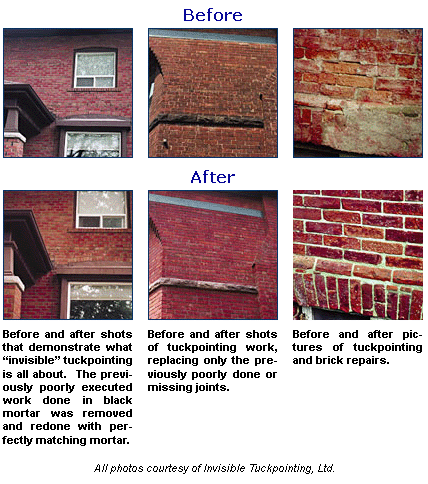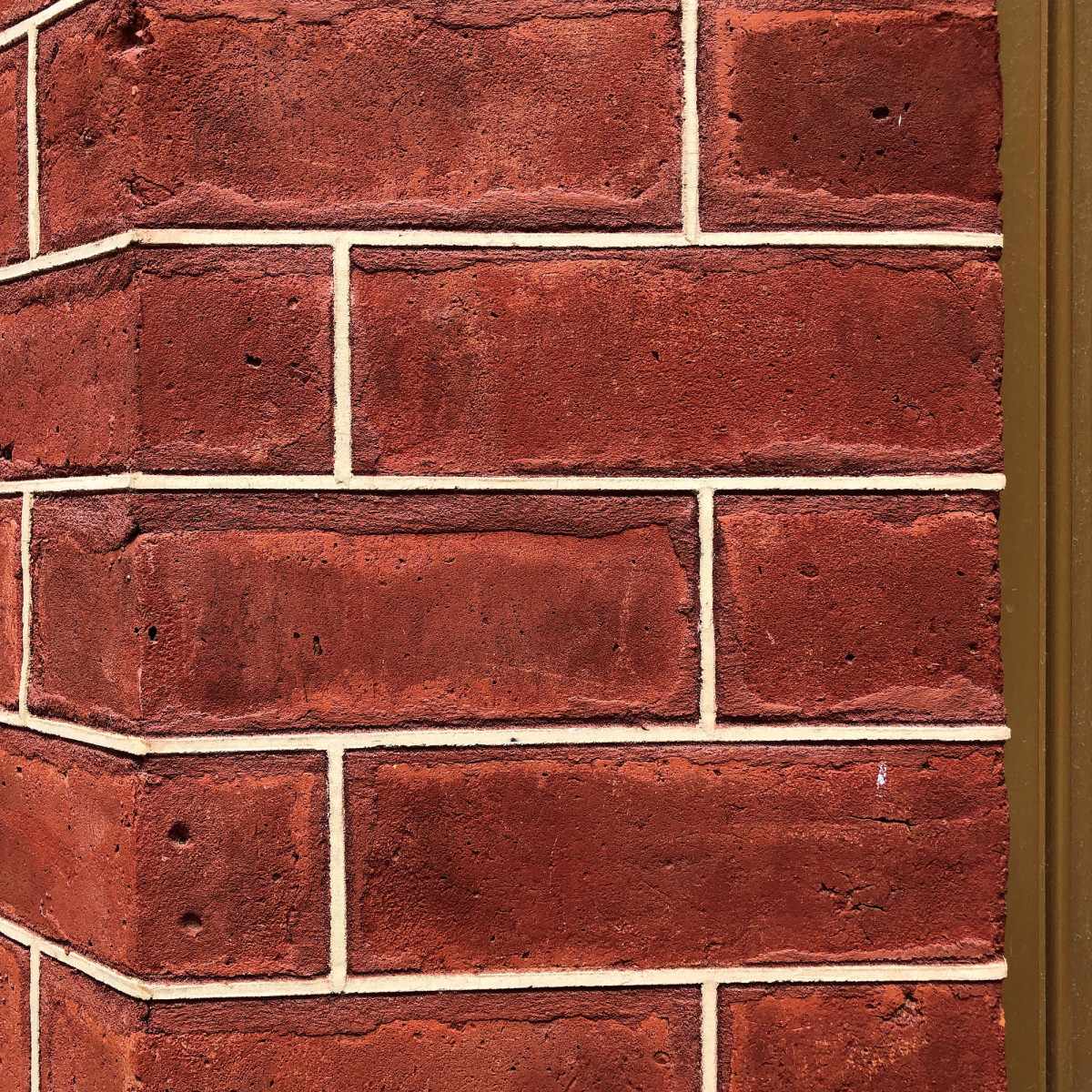Release the Prospective of Your Building with Raul's Tuckpointing St. Louis MO
Wiki Article
Improve the Beauty and Sturdiness of Your Brickwork With Tuckpointing
Brickwork has long been respected for its ageless elegance and durability. Over time, the mortar that holds those bricks with each other can degrade, leaving your structure vulnerable to harm and taking away from its aesthetic appeal. Concern not, for there is an option that can restore both the beauty and longevity of your brickwork: tuckpointing. This old-time method not just enhances the aesthetic appeal of your brickwork, yet likewise enhances its architectural integrity. What precisely is tuckpointing and just how does it differ from repointing? And exactly how can you make sure that your tuckpointed brickwork remains in excellent condition? In this discussion, we will certainly discover the essentials of tuckpointing, its advantages, the distinction between tuckpointing and repointing, the process itself, and the vital practices for caring and maintaining for tuckpointed brickwork.The Essentials of Tuckpointing
Tuckpointing is a knowledgeable strategy utilized to boost the look and fix and architectural honesty of brickwork. It involves the procedure of getting rid of scrubby mortar joints and changing them with fresh mortar. The term "tuckpointing" refers to the method of utilizing two different colors of mortar to produce the illusion of great joints, giving the brickwork an extra refined and visually pleasing appearance.
The very first step in tuckpointing is to carefully analyze the condition of the brickwork. This involves evaluating the mortar joints for signs of wear and tear, such as cracking, crumbling, or missing out on mortar. When the trouble areas have been recognized, the old mortar is carefully eliminated using specialized devices, such as a grinder or chisel, while making certain that the blocks themselves continue to be undamaged.
After the old mortar has been removed, the next action is to prepare the joints for fresh mortar. This usually involves clearing out any particles or loose material and dampening the joints to guarantee proper adhesion. A skilled tuckpointer uses a pointing trowel to very carefully load the joints with fresh mortar, making sure to produce a flush and uniform surface area.
Benefits of Tuckpointing
Improving both the longevity and appearance of brickwork, tuckpointing deals numerous noteworthy advantages for house owners and home owners alike. By replacing scrubby mortar joints, tuckpointing avoids dampness from seeping right into the brickwork, which can lead to structural damage over time.One more advantage of tuckpointing is its ability to boost the aesthetic appeal of block frameworks. In time, mortar joints can come to be broken, faded, or discolored, detracting from the total appearance of the brickwork. Tuckpointing involves very carefully getting rid of the damaged mortar and replacing it with fresh mortar of a different color. This technique enables the creation of tidy, crisp lines that offer the impression of properly maintained brickwork. It can additionally be utilized to produce attractive patterns or layouts, further enhancing the visual appeal of the framework (Raul's Tuckpointing St. Louis MO).
In addition to enhancing the durability and appearance of brickwork, tuckpointing can likewise enhance the value of a property. Properly maintained brickwork is viewed as a preferable feature by prospective purchasers and can substantially improve the curb appeal of a property. This can result in a greater marketing cost and a quicker sale when the time involves put the home on the market.
Tuckpointing Vs. Repointing: What's the Distinction?

To compare tuckpointing and repointing, it is essential to understand the vital distinctions in between these 2 techniques of brickwork remediation. While both methods aim to preserve the structural stability and aesthetic appeal of brickwork, they vary in their strategy and execution.
Tuckpointing is a careful process that involves applying two various colors of mortar to produce the illusion of great joints. This strategy is mainly utilized to improve the aesthetic allure of brickwork by developing the appearance of well-maintained and well-crafted joints. The tinted mortar is carefully used and formed to match the color and profile of the original mortar, offering the impact of precision and craftsmanship.
On the various other hand, repointing is a more simple process that entails eliminating broken or deteriorated mortar from the joints and replacing it with fresh mortar. The main objective of repointing is to bring back the structural honesty of the brickwork by making sure appropriate bonding and securing between the bricks. Unlike tuckpointing, repointing does not include the usage of tinted mortar or the production of an ornamental effect.
The Refine of Tuckpointing
The application of two various colors of mortar to produce the impression of great joints is a precise process referred to as tuckpointing. This technique entails getting rid of deteriorated mortar joints and changing them with new mortar to improve the appearance and structural integrity of the brickwork. their website The procedure of tuckpointing can be divided into numerous steps.First, the old mortar is carefully eliminated making use of specialized tools such as mills and blades. It is essential to remove the mortar to an adequate depth to make sure a strong bond with the brand-new mortar.
Next, the joints are completely cleansed to eliminate any kind of debris or dust. This aids to create a clean surface for the new mortar to comply with.
Once the joints check over here are cleaned, a slim layer of brand-new mortar is applied to the joint using a little pointing trowel. This preliminary layer, referred to as the "punctuating" mortar, is normally the same shade as the existing mortar.
After the preliminary layer has been used, a second layer of mortar is used on top of it. This second layer, called the "fillet" mortar, is a different shade and is very carefully shaped to produce the impression of a great joint.

Maintaining and Caring for Tuckpointed Brickwork
Once the tuckpointing process is finished, proper maintenance and care are important to protect the improved appeal and toughness of the brickwork. This upkeep not only guarantees that the tuckpointed areas continue to be functional and intact yet also aids to avoid any kind of prospective damage to the overall structure.One of the essential aspects of keeping tuckpointed brickwork is regular cleaning. It is important to avoid utilizing any kind of severe chemicals or unpleasant tools that could possibly harm the mortar or the blocks themselves.
In addition to cleaning, it is essential to examine the tuckpointed locations periodically. This enables the early discovery of any type of signs of wear and tear or damage. Any splits, loose mortar, or signs of water damages need to be dealt with promptly to stop further degeneration.
Additionally, guaranteeing correct drain around the brickwork is vital. Water pooling or improper water drainage can bring about moisture penetration, which can damage the mortar and cause structural damage. Clearing downspouts and seamless gutters on a regular basis and guaranteeing that they are properly directed away from the brickwork can aid avoid these issues.
Last but not least, it is suggested to seek advice from with a specialist tuckpointing contractor for routine maintenance and repairs. Their experience and experience can make certain that any kind of needed repair view it now services are done correctly, maintaining the honesty and long life of the tuckpointed brickwork.
Final Thought
To conclude, tuckpointing is a valuable method for enhancing the charm and durability of brickwork. It offers numerous benefits, such as enhancing the structural stability of the stonework and preventing moisture penetration. Tuckpointing includes the elimination and replacement of shabby mortar, causing a consistent and clean look. By appropriately caring and maintaining for tuckpointed brickwork, property owners can ensure its longevity and remain to enjoy its visual charm.
It entails the process of eliminating worn-out mortar joints and changing them with fresh mortar. Raul's Tuckpointing St. Louis MO.After the old mortar has actually been removed, the next action is to prepare the joints for fresh mortar. Tuckpointing entails carefully eliminating the damaged mortar and replacing it with fresh mortar of a different shade. The colored mortar is very carefully used and shaped to match the color and profile of the original mortar, providing the perception of precision and workmanship

Report this wiki page